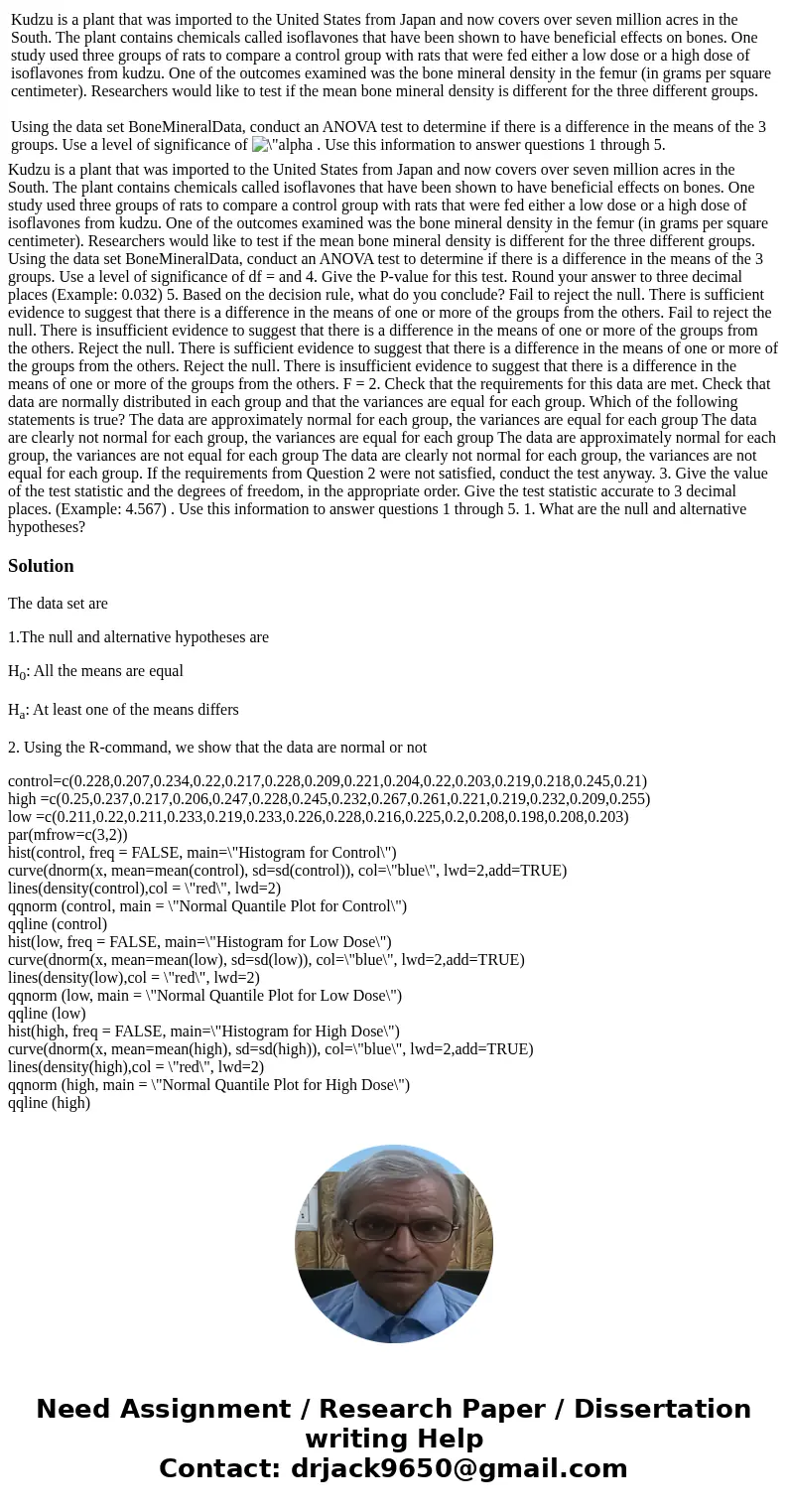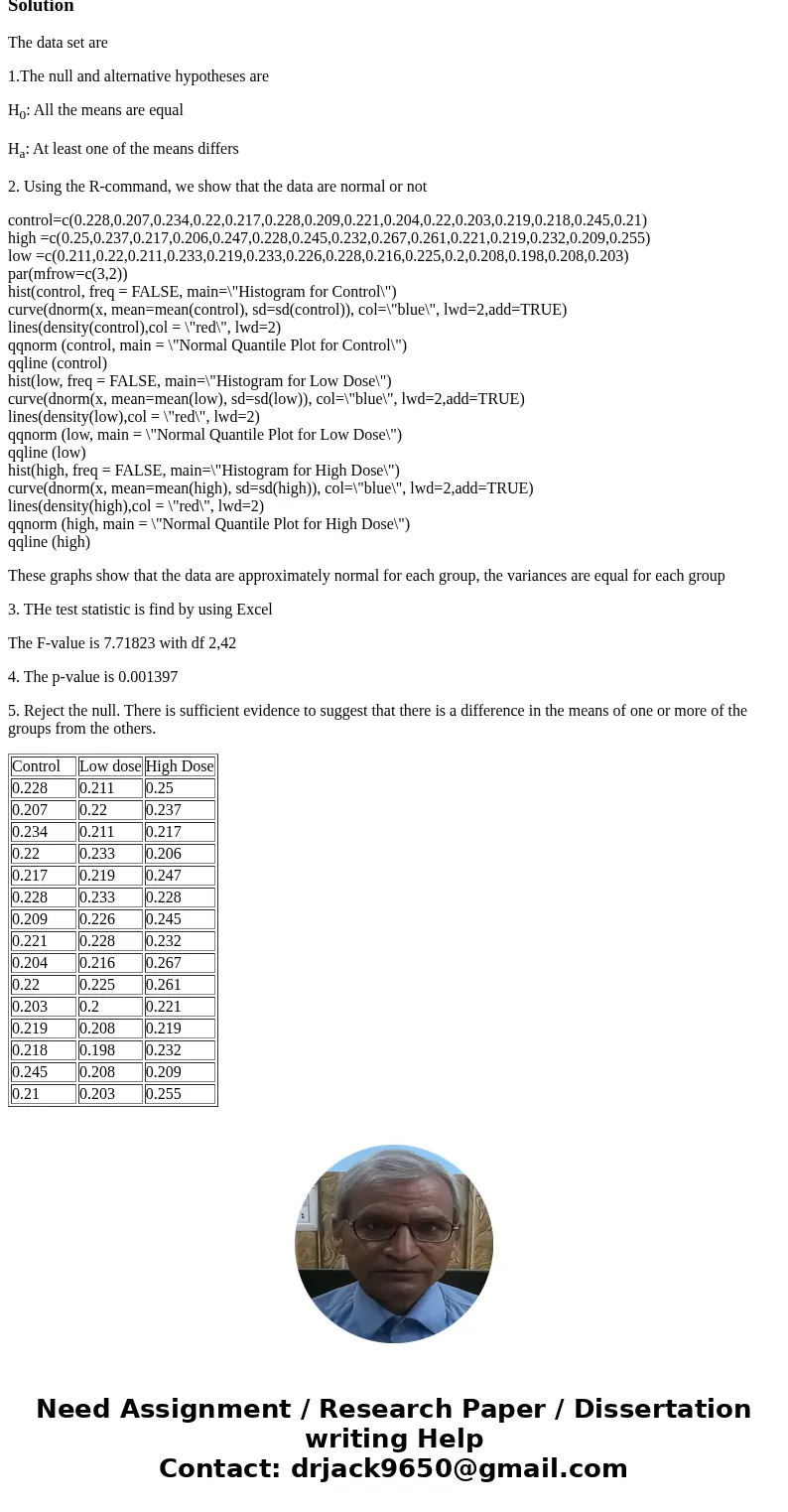Kudzu is a plant that was imported to the United States from
| Kudzu is a plant that was imported to the United States from Japan and now covers over seven million acres in the South. The plant contains chemicals called isoflavones that have been shown to have beneficial effects on bones. One study used three groups of rats to compare a control group with rats that were fed either a low dose or a high dose of isoflavones from kudzu. One of the outcomes examined was the bone mineral density in the femur (in grams per square centimeter). Researchers would like to test if the mean bone mineral density is different for the three different groups. Using the data set BoneMineralData, conduct an ANOVA test to determine if there is a difference in the means of the 3 groups. Use a level of significance of | |
Solution
The data set are
1.The null and alternative hypotheses are
H0: All the means are equal
Ha: At least one of the means differs
2. Using the R-command, we show that the data are normal or not
control=c(0.228,0.207,0.234,0.22,0.217,0.228,0.209,0.221,0.204,0.22,0.203,0.219,0.218,0.245,0.21)
high =c(0.25,0.237,0.217,0.206,0.247,0.228,0.245,0.232,0.267,0.261,0.221,0.219,0.232,0.209,0.255)
low =c(0.211,0.22,0.211,0.233,0.219,0.233,0.226,0.228,0.216,0.225,0.2,0.208,0.198,0.208,0.203)
par(mfrow=c(3,2))
hist(control, freq = FALSE, main=\"Histogram for Control\")
curve(dnorm(x, mean=mean(control), sd=sd(control)), col=\"blue\", lwd=2,add=TRUE)
lines(density(control),col = \"red\", lwd=2)
qqnorm (control, main = \"Normal Quantile Plot for Control\")
qqline (control)
hist(low, freq = FALSE, main=\"Histogram for Low Dose\")
curve(dnorm(x, mean=mean(low), sd=sd(low)), col=\"blue\", lwd=2,add=TRUE)
lines(density(low),col = \"red\", lwd=2)
qqnorm (low, main = \"Normal Quantile Plot for Low Dose\")
qqline (low)
hist(high, freq = FALSE, main=\"Histogram for High Dose\")
curve(dnorm(x, mean=mean(high), sd=sd(high)), col=\"blue\", lwd=2,add=TRUE)
lines(density(high),col = \"red\", lwd=2)
qqnorm (high, main = \"Normal Quantile Plot for High Dose\")
qqline (high)
These graphs show that the data are approximately normal for each group, the variances are equal for each group
3. THe test statistic is find by using Excel
The F-value is 7.71823 with df 2,42
4. The p-value is 0.001397
5. Reject the null. There is sufficient evidence to suggest that there is a difference in the means of one or more of the groups from the others.
| Control | Low dose | High Dose |
| 0.228 | 0.211 | 0.25 |
| 0.207 | 0.22 | 0.237 |
| 0.234 | 0.211 | 0.217 |
| 0.22 | 0.233 | 0.206 |
| 0.217 | 0.219 | 0.247 |
| 0.228 | 0.233 | 0.228 |
| 0.209 | 0.226 | 0.245 |
| 0.221 | 0.228 | 0.232 |
| 0.204 | 0.216 | 0.267 |
| 0.22 | 0.225 | 0.261 |
| 0.203 | 0.2 | 0.221 |
| 0.219 | 0.208 | 0.219 |
| 0.218 | 0.198 | 0.232 |
| 0.245 | 0.208 | 0.209 |
| 0.21 | 0.203 | 0.255 |


 Homework Sourse
Homework Sourse